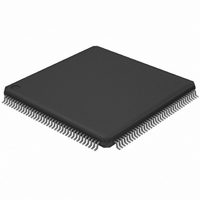LPC2927FBD144,551 NXP Semiconductors, LPC2927FBD144,551 Datasheet - Page 15

LPC2927FBD144,551
Manufacturer Part Number
LPC2927FBD144,551
Description
IC ARM9 MCU FLASH 512K 144LQFP
Manufacturer
NXP Semiconductors
Series
LPC2900r
Datasheet
1.LPC2929FBD144551.pdf
(95 pages)
Specifications of LPC2927FBD144,551
Core Processor
ARM9
Core Size
32-Bit
Speed
125MHz
Connectivity
CAN, EBI/EMI, I²C, LIN, SPI, UART/USART, USB
Peripherals
DMA, POR, PWM, WDT
Number Of I /o
104
Program Memory Size
512KB (512K x 8)
Program Memory Type
FLASH
Eeprom Size
16K x 8
Ram Size
56K x 8
Voltage - Supply (vcc/vdd)
1.71 V ~ 3.6 V
Data Converters
A/D 24x10b
Oscillator Type
Internal
Operating Temperature
-40°C ~ 85°C
Package / Case
144-LQFP
Processor Series
LPC29
Core
ARM968E-S
Data Bus Width
32 bit
Data Ram Size
56 KB
Interface Type
CAN, UART, USB
Maximum Clock Frequency
125 MHz
Number Of Programmable I/os
104
Number Of Timers
6
Operating Supply Voltage
2.7 V to 3.6 V
Maximum Operating Temperature
+ 85 C
Mounting Style
SMD/SMT
3rd Party Development Tools
MDK-ARM, RL-ARM, ULINK2
Minimum Operating Temperature
- 40 C
On-chip Adc
3 (10 bit, 8 Channel)
Package
144LQFP
Device Core
ARM968E-S
Family Name
LPC2900
Maximum Speed
125 MHz
For Use With
568-4786 - EXT BOARD MOTOR CONTROL LPC2900
Lead Free Status / RoHS Status
Lead free / RoHS Compliant
Other names
568-4694
935287117551
LPC2927FBD144-S
935287117551
LPC2927FBD144-S
Available stocks
Company
Part Number
Manufacturer
Quantity
Price
Company:
Part Number:
LPC2927FBD144,551
Manufacturer:
NXP Semiconductors
Quantity:
10 000
NXP Semiconductors
1.
LPC2926_27_29
Product data sheet
Only for 1.8 V power sources
6.6.1 Reset and power-up behavior
6.6.2 Reset strategy
6.6.3 IEEE 1149.1 interface pins (JTAG boundary scan test)
6.6 Reset, debug, test, and power description
The LPC2926/2927/2929 contains external reset input and internal power-up reset
circuits. This ensures that a reset is extended internally until the oscillators and flash have
reached a stable state. See
See
shows the reset pin.
Table 4.
At activation of the RST pin the JTAGSEL pin is sensed as logic LOW. If this is the case
the LPC2926/2927/2929 is assumed to be connected to debug hardware, and internal
circuits re-program the source for the BASE_SYS_CLK to be the crystal oscillator instead
of the Low-Power Ring Oscillator (LP_OSC). This is required because the clock rate when
running at LP_OSC speed is too low for the external debugging environment.
The LPC2926/2927/2929 contains a central module, the Reset Generator Unit (RGU) in
the Power, Clock and Reset Subsystem (PCRSS), which controls all internal reset signals
towards the peripheral modules. The RGU provides individual reset control as well as the
monitoring functions needed for tracing a reset back to source.
The LPC2926/2927/2929 contains boundary-scan test logic according to IEEE 1149.1,
also referred to in this document as Joint Test Action Group (JTAG). The boundary-scan
test pins can be used to connect a debugger probe for the embedded ARM processor. Pin
JTAGSEL selects between boundary-scan mode and debug mode.
boundary scan test pins.
Table 5.
Symbol
RST
Symbol
JTAGSEL
TRST
TMS
TDI
TDO
TCK
Section 9
Reset pin
IEEE 1149.1 boundary-scan test and debug interface
Direction
IN
for characteristics of the several start-up and initialization times.
Description
TAP controller select input. LOW level selects ARM debug mode and HIGH level
selects boundary scan and flash programming; pulled up internally
test reset input; pulled up internally (active LOW)
test mode select input; pulled up internally
test data input, pulled up internally
test data output
test clock input
All information provided in this document is subject to legal disclaimers.
Rev. 5 — 28 September 2010
external reset input, active LOW; pulled up internally
Description
Section 8
for trip levels of the internal power-up reset circuit
ARM9 microcontroller with CAN, LIN, and USB
LPC2926/2927/2929
Table 5
© NXP B.V. 2010. All rights reserved.
shows the
Table 4
15 of 95
1
.















